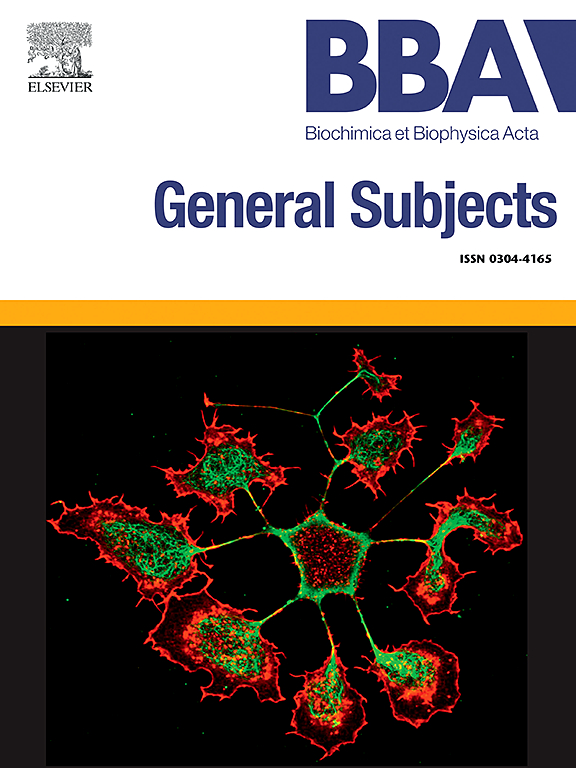硫氧还蛋白的F54L突变表现出蛋白质的不稳定性和催化中心的波动增加。
IF 2.2
3区 生物学
Q3 BIOCHEMISTRY & MOLECULAR BIOLOGY
Biochimica et biophysica acta. General subjects
Pub Date : 2025-09-13
DOI:10.1016/j.bbagen.2025.130860
引用次数: 0
摘要
硫氧还蛋白是一种普遍存在的氧化还原蛋白,通过其保守的二硫醇基序(C32GPC35)作为电子供体,催化二硫醇-二硫交换,调节靶蛋白的氧化还原状态。它通过过氧化物还原素支持抗氧化防御,通过向核糖核苷酸还原酶提供电子促进DNA合成,并调节氧化还原敏感信号通路,包括控制转录和凋亡的信号通路。Txn-F54L突变大鼠出现神经元变性和慢性肾脏疾病;然而,为什么Txn突变导致这些现象的细节仍然未知。本研究旨在阐明F54L突变引起的功能和结构变化。与野生型相比,Thioredoxin-F54L在体温范围内表现出更低的胰岛素降低活性和更强的变性热敏性。晶体结构表明,F54与周围的疏水氨基酸形成疏水相互作用。此外,分子动力学模拟预测F54L突变周围的波动增加,催化中心残基C32和C35之间的距离有扩大的趋势。催化中心残基C32和C35之间距离的增加可能会影响酶对底物的还原活性。发现Thioredoxin- f54l在正常体温下容易变性,可能会降低正常功能的Thioredoxin。硫氧还蛋白- f54l的这些分子特征可能与Txn-F54L大鼠脑和肾脏疾病的发生有关。本文章由计算机程序翻译,如有差异,请以英文原文为准。
The F54L mutation of Thioredoxin shows protein instability and increased fluctuations of the catalytic center
Thioredoxin is a ubiquitous redox protein that acts as an electron donor via its conserved dithiol motif (C32GPC35), catalyzing dithiol–disulfide exchange to regulate the redox state of target proteins. It supports antioxidant defense via peroxiredoxins, facilitates DNA synthesis by donating electrons to ribonucleotide reductase, and regulates redox-sensitive signaling pathways, including those controlling transcription and apoptosis. Neuronal degeneration and chronic kidney disease have been observed in Txn-F54L mutant rats; however, the details of why the Txn mutation causes these phenomena remain unknown. The present study aimed to elucidate the functional and structural changes caused by the F54L mutation. The Thioredoxin-F54L showed less insulin-reducing activity and more thermosensitivity to denaturation in the body temperature range compared to the wild type. The crystal structure revealed that F54 forms hydrophobic interactions with the surrounding hydrophobic amino acids. In addition, molecular dynamics simulation predicts increased fluctuations around the F54L mutation and a tendency for the distance between residues C32 and C35 at the catalytic center to be widened. The increased distance between residues C32 and C35 of the catalytic center may affect the reducing activity of the enzyme on the substrate. The finding that Thioredoxin-F54L is prone to denaturation at normal body temperature may reduce the normally functioning Thioredoxin. These molecular characteristics of Thioredoxin-F54L may be related to brain and kidney disease development in the Txn-F54L rats.
求助全文
通过发布文献求助,成功后即可免费获取论文全文。
去求助
来源期刊

Biochimica et biophysica acta. General subjects
生物-生化与分子生物学
CiteScore
6.40
自引率
0.00%
发文量
139
审稿时长
30 days
期刊介绍:
BBA General Subjects accepts for submission either original, hypothesis-driven studies or reviews covering subjects in biochemistry and biophysics that are considered to have general interest for a wide audience. Manuscripts with interdisciplinary approaches are especially encouraged.
 求助内容:
求助内容: 应助结果提醒方式:
应助结果提醒方式:


